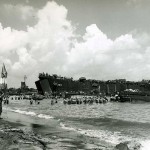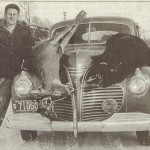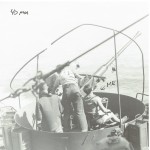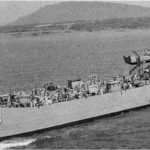Paul Russell
If you were fortunate, you had him as your science teacher at Merrill schools during his 35 years of teaching. If not, like me, you may have had his son Jeff yelling at you on the football practice field near Jay Stadium. If you didn’t fall into one of those categories maybe you had him as your hunter safety instructor or summer school hiking guide in the Rocky Mountains. This story is about Roland Hetfeld and his lifelong service to our state and nation.
His mother influenced Roland to leave Goodman, WI and travel to Los Angeles to work at Lockheed Aircraft Corporation on the Hudson bomber program for Great Britain. After two years, he returned to Wisconsin and bought his first shotgun, a 16 gauge which scored on 30 grouse that fall. Yes 30, Mr. Hetfeld is a science teacher and has the logs to prove it! I guess they didn’t have bag limits in 1941… Shortly after the fall hunt, Pearl Harbor was bombed by Japan and like most from his generation, it was time to find a recruiting station and head to war.
Roland and one of his friends, Melvin Erickson, went to Marinette to enlist in the army. When they arrived, he noticed there was a Coast Guard recruiting station down the street and Roland told his friend he was going to check it out thinking the Coast Guard doesn’t leave the territorial waters of the United States and fight wars. His friend Melvin hit the army station, enlisted and never left the United States during his service! On Nov. 1, 1941, President Roosevelt announces that the U.S. Coast Guard will now be under the direction of the U.S. Navy, a transition of authority usually reserved only for wartime.
The Coast Guard was established as the Revenue Marine Service by Alexander Hamilton, secretary of the treasury, in 1790. During peacetime, the Guard was under the direction of the Department of Treasury until 1967, when the Department of Transportation took control. But during war, it was under the control of the U.S. Navy. What made President Roosevelt’s Nov. 1, 1941 announcement significant was that the United States was not yet at war – but more and more American ships were nevertheless becoming casualties of the European war. On Feb. 25, 2003 it became part of the Department of Homeland Security.
In 1942, Roland was 20 years old and went to boot camp south of Brooklyn, New York. He was then shipped to Florida for two weeks of training and finally on to San Juan, Puerto Rico for his first duty assignment. Hunting Nazi submarines that were attacking cargo ships was the mission. After many hours of guard duty with his 30-06 Springfield rifle and night patrols on wooden sub chasers, Roland was off to radio school in Atlantic City.
RM1C Hetfeld was finally on his way to the South Pacific and landed in Port Moresby, New Guinea. He spent some time on a smaller ship before being assigned to LST 204. He was involved in four invasions that included Western New Guinea, Leyte, Luzon and the consolidation and capture of the Philippine Islands.
The northernmost island in the Philippines was one invasion, January 1945 Lingaygen Gulf landings, as part of the Luzon operations. Troop loads of soldiers from Wisconsin of the famed 32nd Red Arrow division soldiers were on board LST 204. One LST ship alongside 204 was hit by a torpedo and was blown in half. Mr. Hetfeld recalls the horror of seeing the ship sink in less than a minute wondering about the fate of those on board. Shortly thereafter, another Japanese torpedo missed the bow of LST 204 by 50 yards.
The invasion where he was wounded by a Japanese bomber occurred on the beachhead when they were offloading vehicles. The smoke dispensers on his LST did not engage and left them in the open when the Betty bomber dropped bombs on them. Six suffered shrapnel wounds, some severely but you never received word on their status after they evacuated. The Betty bomber was shot down shortly after the bombs exploded.
Mr. Hetfeld was awarded a bronze star and purple heart for his actions during the first three invasions. His final orders were to clean up POW camps mainly filled with Filipino people. If you served in the South Pacific during World War II, you were acutely aware of the atrocity reports on Japanese treatment of Allied prisoners. One of these POW’s was his friend Jack Sowers from Marinette.
Jack was an aircraft mechanic stationed at Clark Field when it was bombed by the Japanese days after Pearl Harbor. Japanese fighter planes landed at the field and would taxi around shooting their machine guns at airmen and undamaged equipment. From a perimeter ditch where he and others had taken cover, he fired six shots with his .45 cal pistol and killed one of the pilots in the cockpit. Even more amazing, he survived three years as a POW that included time in one of the “hell ships” and the Corregidor march. When he was liberated from a labor camp in Japan at the end of the war, he weighed 83 pounds.
When combat operations had ended, LST 204 was tasked with towing another LST back to Pearl Harbor. Roland recalls the long journey travelling at only four knots an hour. Upon arrival in Hawaii, they were disappointed to hear they only had a three-hour liberty pass on shore. Mr. Hetfeld’s memory was “that was enough time for all of us to get stewed and tattooed.” They set sail again and made it to San Francisco in time for New Year’s 1945. He and his best friend Ross Hefner celebrated their return from the war. Ross was a tough Texan rodeo cowboy and boxer. The two of them dreamed of starting a horse ranch in Montana after the war. Roland and his wife named their late son Ross after his best friend.
Roland returned home and married the late Frances Anderson in March of 1946. They celebrated 66 years together and had three sons, Carl, Jeff and Ross; and eight grandchildren. He initially worked for the Wisconsin Conservation Department (pre-DNR) before attending UW Superior. His dedication to education spanned over 36 years and included; principal K-8 in Goodman, Science teacher MAPS, UW Marathon and work with the National Science Foundation. His time off allowed him to pursue his passion of the outdoors: Hunting, fishing, trapping and conservation. His logs show over 50 whitetail bucks bagged during his lifetime including his famous 12-pointer story!
His efforts outside the classroom were just as impressive. He served as director of Camp Birch Trails for six years, volunteered at Merrill School Forest, certified over 500 students in hunter safety and guided summer school students for eight years out to Yellowstone National Park. In August of 2009, Mr. Hetfeld received a letter from one of his former students, Raymond Stefanski, detailing stories from his class of 1958. One of them was thanking Roland for saving the life of a student who nearly drowned during a field trip to the Peshtigo River. Another was thanking him for being a mentor and teacher that impacted so many students in a positive manner. Mr. Stefanski had included his PhD level study he completed on the Stefanski–Dziedzic Highlands for Wildlife as a tribute to Mr. Hetfeld.
Mr. Hetfeld turned 93 on June 3 of this year and had already been out road hunting for grouse the last time we talked. Roland is a lifetime member of the Merrill Veterans of Foreign Wars (VFW) Post 1638 and resides in Merrill. Mr. Hetfeld, thank you for your service to our nation, state and community – you have made a difference for future generations.
Editors note: Paul Russell is a veteran of Afghanistan and served 31 years total in the military.





